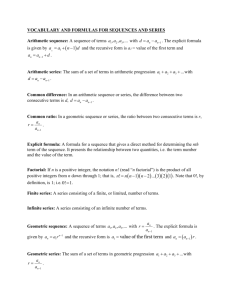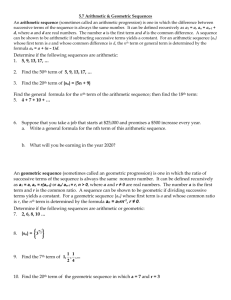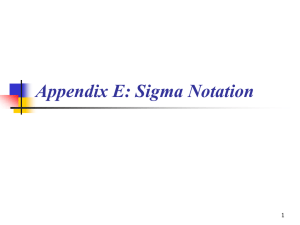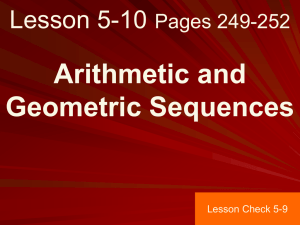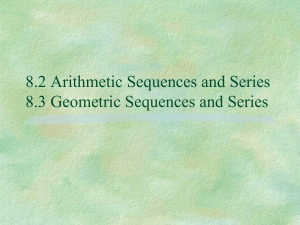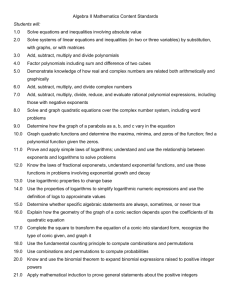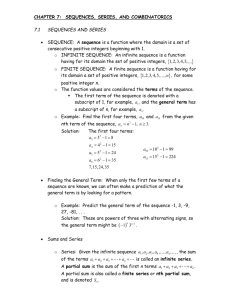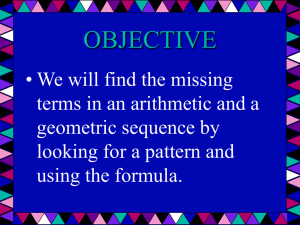pptx - Newport Math Club
advertisement
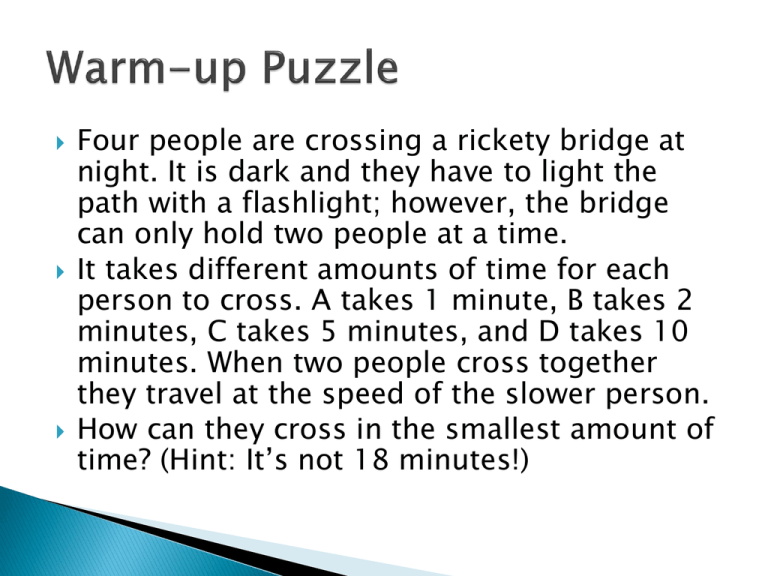
Four people are crossing a rickety bridge at night. It is dark and they have to light the path with a flashlight; however, the bridge can only hold two people at a time. It takes different amounts of time for each person to cross. A takes 1 minute, B takes 2 minutes, C takes 5 minutes, and D takes 10 minutes. When two people cross together they travel at the speed of the slower person. How can they cross in the smallest amount of time? (Hint: It’s not 18 minutes!) An arithmetic sequence is defined as a sequence of numbers in which each number is given by adding a fixed value to the previous term. This value is called the common difference. Examples: The general form of an arithmetic sequence is Note that arithmetic sequences can be finite or infinite. Also important to note is the formula for the nth term given the initial value and the common difference. An arithmetic series is a summation of successive terms of an arithmetic sequence. You’ve probably already seen some simple series and how to solve them. What is the sum in terms of n? We can use this to write a general form for summing an arithmetic series. To find the sum, take the average of the first and last term and multiply by the number of terms, n. These may sound obvious, but they are important!! The difference between adjacent terms is constant. For is constant. The middle term (or average of the two, if n is even) is the average of all the terms. In the five-sided star shown, the letters A, B, C, D, and E are replaced by the numbers 3, 5, 6, 7, and 9, although not necessarily in this order. The sums of the numbers at the ends of the line segments AB, BC, CD, DE, and EF form an arithmetic sequence, although not necessarily in this order. What is the middle term of the sequence? How many non-similar triangles have angles whose degree measures are distinct positive integers in arithmetic progression? A number of linked rings, each 1 cm thick, are hanging on a peg. The top ring has an outside diameter of 20 cm. The outside diameter of each of the outer rings is 1 cm less than that of the ring above it. The bottom ring has an outside diameter of 3 cm. What is the distance, in cm, from the top of the top ring to the bottom of the bottom ring? A geometric sequence is a sequence where each number is a fixed multiple of the previous term. That is, the ratio between successive terms is constant. This ratio is known as the common ratio. Examples: The general form of a geometric sequence is Note that geometric sequences can be finite or infinite. Also important to note is the formula for the nth term given the initial value and the common ratio. A geometric series is a summation of successive terms of a geometric sequence. Let’s try one! Using the same techniques, we can derive a formula for the general case. Multiply by r. Subtract the two equations and cancel like terms, and we get So far we’ve looked at finite geometric series. What about infinite geometric series? (Also, why not infinite arithmetic series?) Evaluate: We can use the same techniques to find a formula for the exact value to which infinite geometric series converge. Note that this formula only works when the series does converge— that is, when |r|<1 An infinite geometric series has sum 2005. A new series, obtained by squaring each term of the original series, has 10 times the sum of the original series. The common ratio of the original series is where and are relatively prime integers. Find . A high school basketball game between the Raiders and Wildcats was tied at the end of the first quarter. The number of points scored by the Raiders in each of the four quarters formed an increasing geometric sequence, and the number of points scored by the Wildcats in each of the four quarters formed an increasing arithmetic sequence. At the end of the fourth quarter, the Raiders had won by one point. Neither team scored more than 100 points. What was the total number of points scored by the two teams in the first half?

